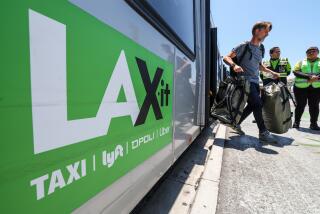Short-haul flights lose favor with fliers
- Share via
Reporting from Dallas — In 1990, Southwest Airlines Co.’s best route — the one with the most passengers — was one of its first: Dallas Love Field to Houston.
That’s still true today. But the old route isn’t quite the pearl it used to be.
Southwest carried 1.5 million passengers between Love Field and Houston Hobby airports in 1990. In 2009, that number had plummeted to just over 1 million passengers, a drop of nearly one-third.
In fact, the number of travelers on many short-haul routes has dropped significantly in the past two decades. Passengers have been chased away by a combination of factors — higher fares, more airport hassles, repeated recessions, new technology for video meetings — even as the number of travelers boarding U.S. airlines has climbed.
According to U.S. Bureau of Transportation Statistics data, it’s a phenomenon that has hit many routes and most airlines. Consider these numbers:
• In 1990, people flying on short-haul routes, 400 miles or less, made up nearly 34% of domestic passengers on U.S. airlines. In 2009, the last year for which full numbers are available, the percentage had dropped to 26.6%.
Southwest saw the share of its annual passenger load who take short-haul flights decline from nearly 59% in 1990 to just under 35% by 2009.
The average Southwest passenger in 1990 traveled 502 miles each way. In 2009, that average trip lengthened to 863 miles, a 72% increase.
Aviation consultant Michael Boyd, who advises airports on how to attract new service, said the trend was a national one.
“Air transportation does not work for many short-haul markets as well as it did for 20 or 30 years, for a couple of reasons,” Boyd said.
“One, you do have the security issue. The elapsed time takes you longer. There is a perceived hassle factor. That’s in there somewhere, probably more so than we might think,” said Boyd, president of the Boyd Group in Evergreen, Colo.
“But, more importantly, the costs have gone through the ceiling,” he said, emphasizing, “It’s not just Love Field.”
As airfares have gone up, the number of people willing to pay them has gone down, and those increases have particularly hit shorter routes.
“Thirty years ago, there were about 40,000 people who flew between Albany [N.Y.] and Boston. Today there’s probably about 1,000, and they’re connecting,” Boyd said. “Same thing between Albany and [ New York] LaGuardia — there’s almost no traffic at all.”.
“ Bangor [ Maine]-to-Boston was a No. 1 route out of Bangor. Today you can’t fill a Yugo in that market,” he said.
For Southwest the declines can partially be explained by the fact that the airline, known as a short-haul, regional carrier for much of its history, has simply changed as it has matured.
Southwest has added more long-haul routes to its system as it has grown into the largest U.S. carrier in terms of domestic passengers carried.
But Southwest Chief Executive Gary Kelly said it was much more than that, as Southwest is just one player in a national story. And the national story is that many short-haul routes are handling fewer passengers today than 10 or 20 years ago.
For example, 2.2 million passengers flew between Phoenix and Los Angeles in 1990, according to Bureau of Transportation Statistics data. By 2009, that had dropped to just under 1.3 million, a 41% drop.
On the 185-mile route between Boston Logan and LaGuardia, the passenger totals dropped from 1.8 million in 1990 to 1 million in 2009, down 45%.
The 237-mile route between St. Louis and Kansas City, Mo., has seen a 48% decline in passengers, from 430,600 in 1990 to 223,835 in 2009.
“One has to speculate about the causes, but what we do know historically about short-haul travel is that it tends to be dominated by business travelers,” Kelly said. “Because of that it is very sensitive to the economic cycle. In recessions we have always experienced a drop in business travel.”
The airline industry was still recovering from the recession that began in 2001 when the latest recession hit, Kelly said.
The effect of recessions on the number of long-haul business travelers is “not even remotely close” to the much deeper effect on short-haul passengers, he said.
“We know a couple of things: We know that short-haul traffic is more elastic and price-sensitive than long-haul traffic,” Kelly said.
For long-haul travelers, “You just don’t have the drive option. Buses aren’t an option. Trains aren’t an option. There’s just not the competition,” he said.
Maxon writes for the Dallas Morning News/McClatchy.
More to Read
Sign up for The Wild
We’ll help you find the best places to hike, bike and run, as well as the perfect silent spots for meditation and yoga.
You may occasionally receive promotional content from the Los Angeles Times.






